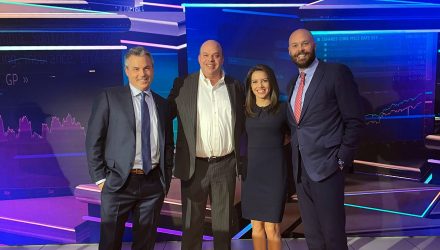In the latest episode of “Bloomberg’s ETF IQ,” Bloomberg’s Matt Miller, Katie Greifeld, and Eric Balchunas spoke with VettaFi’s head of research Todd Rosenbluth, and BNY Mellon Investment Management’s Stephanie Pierce about the latest in the banking sector.
The Rise of Ultra-Short ETFs
Following the banking crisis spurred by the sudden collapse of Silicon Valley Bank and Signature Bank, Pierce said that she has seen “unbelievable flows” going into money market funds, which “would suggest that this is not entirely over. She added that, in addition to money market funds, BNY Mellon IM has “seen unbelievable money in motion in the short end of the curve” going towards ultra-short bond ETFs.
“We’ve equally seen people looking for alternatives in the ETF space, particularly with ultra-short ETFs,” Pierce said.
Shortly after, Balchunas asked Rosenbluth to walk us through the lay of the land of ultra-short funds. Rosenbluth explained that the ultra-short category has become “really popular” with financial advisors. VettaFi recently asked advisors where they saw the greatest opportunity over the next 12 months within fixed income, and ultra-short was the category they chose.
“You’ve got a wide range of options,” Rosenbluth said, citing actively managed products like the JPMorgan Ultra-Short Income ETF (JPST), floating rate products like the WisdomTree Floating Rate Treasury Fund (USFR), and ultra-short treasury bill ETFs like the SPDR Bloomberg 1-3 Month T-Bill ETF (BIL).
“So, you want to make sure you understand the interest rate risk that you’re taking on, you want to make sure you understand whether this is actively managed and thus it might shift from one to another within the overall fixed income category,” Rosenbluth added.
Where Active Management Can Come Into Play
While the Federal Reserve has been adamant that it does not want to cut interest rates this year, Miller noted that if something else breaks, they may have no choice. And with the recent uncertainty over the Fed’s plans and overall market uncertainty, Rosenbluth said “that’s where active can come into play,” with ETFs like the PIMCO Active Bond ETF (BOND) and the SPDR DoubleLine Total Return Tactical ETF (TOTL).
“That’s where we’re seeing really strong interest in actively managed ETFs this year. It’s because of the uncertainty with the Fed, it’s the uncertainty overall,” he said, noting that there’s now “a whole range” of active managers like Capital Group “that have been popular.”
Pierce points out that in the first two months of this year, active ETFs accounted for 40% of all ETF flows.
“That tells you people are voting with their feet and they just really prefer this vehicle for almost every asset class,” Peirce said.
Rosenbluth agreed. “We’re seeing advisors, investors, increasingly turn towards actively managed ETFs because they want somebody helping drive the car as opposed to having to do it themselves,” he said.
Is ESG Less Shiny?
Balchunas noted that while ultra-short is the shiny new thing in the ETF world, one category he thinks has lost some of its luster is ESG funds. Citing the outflows from the iShares ESG Aware MSCI USA ETF (ESGU), Balchunas said that he thinks the sector is reaching an inflection point where ESG funds will be pushed to the fringes.
Rosenbluth disagreed, countering with the iShares MSCI USA Quality Factor ETF (QUAL), which has seen inflows. He added that he believed “an institutional investor moved away from ESGU to get a higher quality tilt towards large-cap companies given the market uncertainty.”
“So, this was not a call on ESG in particular,” he said, adding that it was a call made by one investor to fight the overall market through quality investments.
“But ESG ETFs have survived,” Rosenbluth said, adding that asset managers are continuing to offer these ETFs “because advisors are still showing some interest.”
For more news, information, and analysis, visit VettaFi | ETF Trends.
